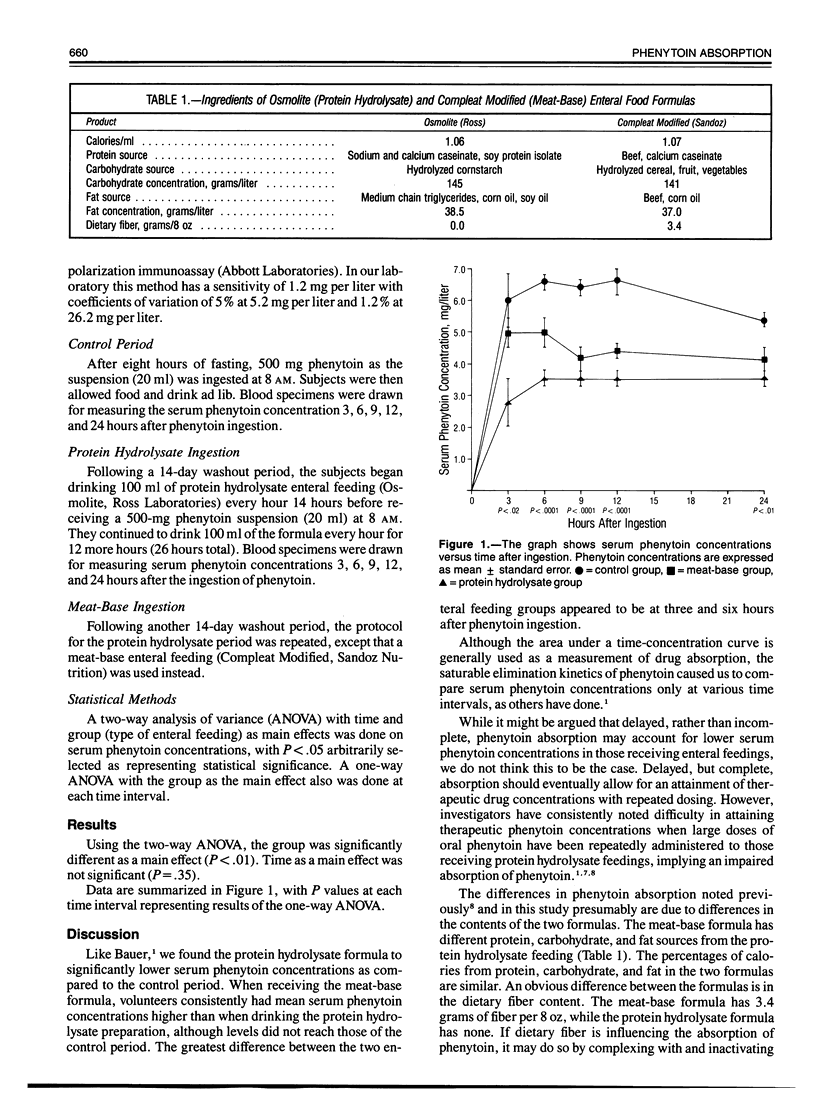Abstract
Phenytoin absorption is reportedly significantly altered in the presence of continuously administered enteral feedings, resulting in subtherapeutic serum phenytoin concentrations and loss of seizure control. We administered 500 mg of phenytoin as the suspension to five volunteers who were not receiving enteral feeding, again while they ingested protein hydrolysate enteral feedings hourly, and again during hourly ingestions of meat-base enteral feeding. Serum phenytoin concentrations, measured 3, 6, 9, 12, and 24 hours after phenytoin ingestion, were lowest with protein hydrolysate feedings. Mean serum phenytoin concentrations were consistently higher with the meat-base feeding than with the protein hydrolysate formula, although levels did not reach those of the control period. These data are in keeping with our previous observation that it is easier to attain therapeutic serum phenytoin concentrations in patients receiving a meat-base enteral feeding than in those receiving a protein hydrolysate formula.
Full text
PDF


Selected References
These references are in PubMed. This may not be the complete list of references from this article.
- Bauer L. A. Interference of oral phenytoin absorption by continuous nasogastric feedings. Neurology. 1982 May;32(5):570–572. doi: 10.1212/wnl.32.5.570. [DOI] [PubMed] [Google Scholar]
- Cacek A. T. Review of alterations in oral phenytoin bioavailability associated with formulation, antacids, and food. Ther Drug Monit. 1986;8(2):166–171. doi: 10.1097/00007691-198606000-00007. [DOI] [PubMed] [Google Scholar]
- Holtz L., Milton J., Sturek J. K. Compatibility of medications with enteral feedings. JPEN J Parenter Enteral Nutr. 1987 Mar-Apr;11(2):183–186. doi: 10.1177/0148607187011002183. [DOI] [PubMed] [Google Scholar]
- Hooks M. A., Longe R. L., Taylor A. T., Francisco G. E. Recovery of phenytoin from an enteral nutrient formula. Am J Hosp Pharm. 1986 Mar;43(3):685–688. [PubMed] [Google Scholar]
- Maynard G. A., Jones K. M., Guidry J. R. Phenytoin absorption from tube feedings. Arch Intern Med. 1987 Oct;147(10):1821–1821. [PubMed] [Google Scholar]
- Ozuna J., Friel P. Effect of enteral tube feeding on serum phenytoin levels. J Neurosurg Nurs. 1984 Dec;16(6):289–291. doi: 10.1097/01376517-198412000-00002. [DOI] [PubMed] [Google Scholar]
- Saklad J. J., Graves R. H., Sharp W. P. Interaction of oral phenytoin with enteral feedings. JPEN J Parenter Enteral Nutr. 1986 May-Jun;10(3):322–323. doi: 10.1177/0148607186010003322. [DOI] [PubMed] [Google Scholar]
- Worden J. P., Jr, Wood C. A., Jr, Workman C. H. Phenytoin and nasogastric feedings. Neurology. 1984 Jan;34(1):132–132. doi: 10.1212/wnl.34.1.132. [DOI] [PubMed] [Google Scholar]


